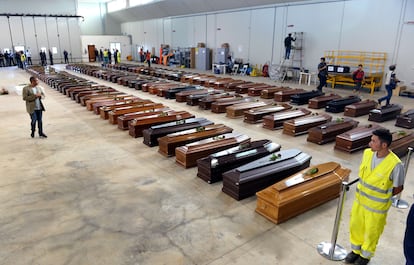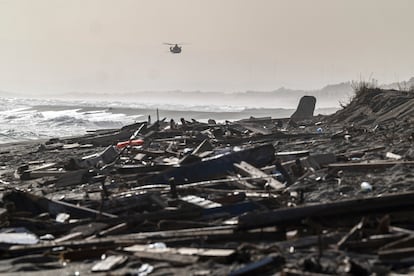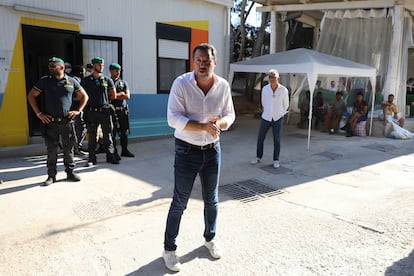From Lampedusa to Calabria: 10 years of immigration policy failures
The tragedy on the Sicilian island in 2013 marked a turning point in Italy’s political discourse, but a decade later nothing has changed and 26,000 people have died in the Mediterranean


On October 3, 2013, an old fishing vessel with around 500 migrants aboard that had set out from the coast of Libya sighted land half a mile away: the Sicilian island of Lampedusa, the closest entry point into Europe for the Somalian and Eritrean passengers. Two other boats had entered the port shortly beforehand. It was 5am and so the migrants set fire to a blanket to attract the attention of search and rescue teams. But the blaze swiftly engulfed the entire ship and its occupants dived into the ocean as it sank. In the worst migrant-related catastrophe on Italy’s coasts, 368 people died. It was a tragedy that would leave an indelible mark on Italian politics, the country’s relationship with Europe and the electoral cycles that would follow over the course of the ensuing decade. Until last Sunday.
The sinking of a migrant ship off the Steccato di Cutro beach in Calabria, southern Italy, in which at least 63 people are confirmed to have perished with the toll expected to rise, may have occurred a decade after the Lampedusa tragedy, but in many ways, it was very similar. It is a reflection of a different type of problem and occurred in a country very different from the Italy of 10 years ago, when the leftist administration of Enrico Letta was in power, while today the far-right governs in Rome. Practically everything has changed since then, except the human cost and the glaring communal failure to reach an agreement between the European Union and its member states to solve a chronic crisis. The seas of southern Europe remain a graveyard where some 26,000 migrants have perished over the last decade, according to the International Organization for Migration.

Lampedusa was the beginning and ushered in a syndrome that would give rise to the political phenomena that followed. The migration issue, the social alarm it raised and the electoral instrumentalization of the tragedy opened the door to one of the strongest populist winds in Europe. Over the next five years, 600,000 migrants arrived in Italy. The lack of a clear response from the EU and the chaotic management of their reception - in many cases in the hands of organized crime - made the issue the central focus of the March 4, 2017 elections, which were won by Giuseppe Conte’s Five Star Movement (M5S). Any party that wished to govern Italy had to deliver a tough discourse on immigration. The Democratic Party toed a similar line, entrusting the issue to the Minister of the Interior between 2016 and 2018, Marco Minniti, who established an agreement with Libya to prevent migrants from attempting to reach Italy in what became widely known as the “memorandum of shame.”
The barren 20 square kilometers (7.7 square miles) of Lampedusa - an island of 5,800 inhabitants that was turned into a symbol of universal welcome following the visit of Pope Francis in the aftermath of the 2013 shipwreck - soon provided a perfect portrait of an inflamed society, particularly through the anti-immigration rhetoric of parties such as Matteo Salvini’s Northern League, which was then growing exponentially in the polls on the back of its xenophobic discourse. Lampedusa installed a new mayor and adopted a different narrative. Something similar began happening in many municipalities across Italy, even in those that were traditional bastions of the left, the old fiefdoms of the Communist Party. In 2016, arrivals by sea reached a peak of 186,000 people, according to the Italian Interior Ministry. Immigration was the issue and those who wished not to see it were not going to take part in any photo-ops.
Since then, Italy has had seven different governments and six prime ministers. The battle against illegal immigration was the banner of the coalition formed by the Northern League and M5S in 2017, which converted the NGOs - which had multiplied after the Lampedusa tragedy and in the face of increasing migratory flows - into the main enemy of the government. Salvini, then Minister of the Interior, ordered the NGO boats into dry dock, led a media fight against the captain of one such vessel, Carola Rackete, and was tried on charges of kidnapping. There has so far been no movement in Brussels and arrivals by sea remain very high in Italy: 104,061 in 2022.

Despite multiple attempts, the EU has not managed to find a formula to stop irregular immigration, or to balance its weight and consequences among its member states. The migration pact that the European Commission launched in 2020 is practically at a standstill due to deep divisions. Of the 8,000 offers to relocate migrants by the 21 EU states that signed up to the agreement, only 3% have materialized to date. The shipwreck in Calabria now closes another cycle and Italy will surely use it again to press for a solution that will facilitate the redistribution of migrants entering Europe through its borders. In fact, the latest tragedy marks the first time that the majority of Italian authorities, including President Sergio Mattarella, have directly targeted Brussels. Beyond electoral issues, nothing indicates that the Calabria shipwreck will lead to changes in the short term, as was the case with Lampedusa in 2013.
Sign up for our weekly newsletter to get more English-language news coverage from EL PAÍS USA Edition
Tu suscripción se está usando en otro dispositivo
¿Quieres añadir otro usuario a tu suscripción?
Si continúas leyendo en este dispositivo, no se podrá leer en el otro.
FlechaTu suscripción se está usando en otro dispositivo y solo puedes acceder a EL PAÍS desde un dispositivo a la vez.
Si quieres compartir tu cuenta, cambia tu suscripción a la modalidad Premium, así podrás añadir otro usuario. Cada uno accederá con su propia cuenta de email, lo que os permitirá personalizar vuestra experiencia en EL PAÍS.
¿Tienes una suscripción de empresa? Accede aquí para contratar más cuentas.
En el caso de no saber quién está usando tu cuenta, te recomendamos cambiar tu contraseña aquí.
Si decides continuar compartiendo tu cuenta, este mensaje se mostrará en tu dispositivo y en el de la otra persona que está usando tu cuenta de forma indefinida, afectando a tu experiencia de lectura. Puedes consultar aquí los términos y condiciones de la suscripción digital.
More information
Archived In
Últimas noticias
Most viewed
- Sinaloa Cartel war is taking its toll on Los Chapitos
- Oona Chaplin: ‘I told James Cameron that I was living in a treehouse and starting a permaculture project with a friend’
- Reinhard Genzel, Nobel laureate in physics: ‘One-minute videos will never give you the truth’
- Why the price of coffee has skyrocketed: from Brazilian plantations to specialty coffee houses
- Silver prices are going crazy: This is what’s fueling the rally










































